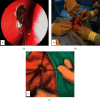A Comparison of Transcanalicular, Endonasal, and External Dacryocystorhinostomy in Functional Epiphora: A Minimum Two-Year Follow-Up Study
- PMID: 35369002
- PMCID: PMC8967575
- DOI: 10.1155/2022/3996854
A Comparison of Transcanalicular, Endonasal, and External Dacryocystorhinostomy in Functional Epiphora: A Minimum Two-Year Follow-Up Study
Abstract
Purpose: To compare the outcomes of transcanalicular diode laser-assisted dacryocystorhinostomy (TCL-DCR), nonendoscopic endonasal dacryocystorhinostomy (NEN-DCR), and external dacryocystorhinostomy (EXT-DCR) as first-line treatments for functional epiphora.
Methods: This multicenter, retrospective, case-control study included 135 eyes of 135 patients with functional epiphora (86 females and 49 males). Functional epiphora was diagnosed based on a patent lacrimal system with a delay in the fluorescein dye disappearance test (FDDT) or dacryoscintigraphy (DSG) and no ocular surface or eyelid abnormalities. The patients were treated with TCL-DCR (2008-2011) or Ext-DCR (2005-2008, 2011-2017) at Beyoglu Eye Research Hospital (Istanbul, Turkey) and NEN-DCR at Carrot Eye Surgery Clinic affiliated with the McMaster University (Hamilton, ON, Canada) (2010-2016). Success was defined as the absence of epiphora and the normalization of an earlier delayed FDDT after surgery.
Results: The TCL-DCR, NEN-DCR, and EXT-DCR groups consisted of 38, 47, and 50 eyes with 25.9, 44.2, and 45.9 months of follow-up. The success rate for TCL-DCR was 65.8%, 70.2% for NEN-DCR, and 84.0% for EXT-DCR. During the follow-up period, 13.2% of TCL-DCR cases and 6.4% of NEN-DCR cases developed an anatomic obstruction of the lacrimal system.
Conclusion: The EXT-DCR group had a higher success rate in the management of functional epiphora than the NEN-DCR and TCL-DCR groups and was significantly safer in terms of an iatrogenic anatomic block of the lacrimal system.
Copyright © 2022 Can Ozturker et al.
Conflict of interest statement
The authors declare that they have no conflicts of interest.
Figures




Similar articles
-
Best treatments available for distal acquired lacrimal obstruction: A systematic review and meta-analysis.Clin Otolaryngol. 2020 Jul;45(4):545-557. doi: 10.1111/coa.13551. Epub 2020 May 6. Clin Otolaryngol. 2020. PMID: 32304619
-
Primary nonendoscopic endonasal versus external dacryocystorhinostomy in nasolacrimal duct obstruction in children.Indian J Ophthalmol. 2017 Oct;65(10):1004-1007. doi: 10.4103/ijo.IJO_188_17. Indian J Ophthalmol. 2017. PMID: 29044069 Free PMC article.
-
Fluorescein transit test time as a tool to assess lacrimal pump function after diode laser transcanalicular dacryocystorhinostomy and external dacryocysto-rhinostomy.Rhinology. 2018 Sep 1;56(3):274-278. doi: 10.4193/Rhin17.254. Rhinology. 2018. PMID: 29509829
-
Incompatibility of Lacrimal Syringing Test with Dacryoscintigraphy in Patients Undergoing Successful Dacryocystorhinostomy Surgery.World J Nucl Med. 2024 Aug 16;23(4):250-255. doi: 10.1055/s-0044-1788595. eCollection 2024 Dec. World J Nucl Med. 2024. PMID: 39677343 Free PMC article.
-
[Minimally invasive bypass surgery for nasolacrimal duct obstruction : Transcanalicular laser-assisted dacryocystorhinostomy].Ophthalmologe. 2017 May;114(5):416-423. doi: 10.1007/s00347-017-0466-2. Ophthalmologe. 2017. PMID: 28239778 Review. German.
Cited by
-
Congenital Nasolacrimal Duct Obstruction: Natural Course, Diagnosis and Therapeutic Strategies.J Clin Med. 2025 May 26;14(11):3716. doi: 10.3390/jcm14113716. J Clin Med. 2025. PMID: 40507477 Free PMC article. Review.
-
Functional outcome and quality of life index after endonasal versus external dacryocystorhinostomy.Indian J Ophthalmol. 2025 Feb 1;73(2):244-248. doi: 10.4103/IJO.IJO_521_24. Epub 2024 Sep 19. Indian J Ophthalmol. 2025. PMID: 39297485 Free PMC article.
-
Interventions in functional epiphora-a systematic review.Int J Ophthalmol. 2025 May 18;18(5):937-950. doi: 10.18240/ijo.2025.05.21. eCollection 2025. Int J Ophthalmol. 2025. PMID: 40385127 Free PMC article. Review.
-
Long-Term Outcomes of Revisional Powered Endoscopic Dacryocystorhinostomy (EnDCR) with Intraoperative Application of Mitomycin C in Patients After Failed Laser-Assisted (LDCR) or External Dacryocystorhinostomy (ExDCR).J Clin Med. 2025 Apr 30;14(9):3116. doi: 10.3390/jcm14093116. J Clin Med. 2025. PMID: 40364146 Free PMC article.
References
LinkOut - more resources
Full Text Sources
Miscellaneous

